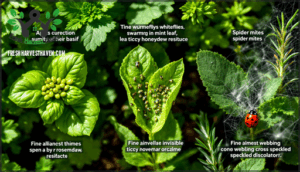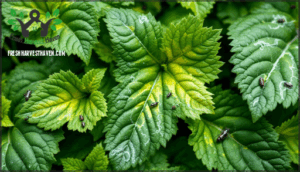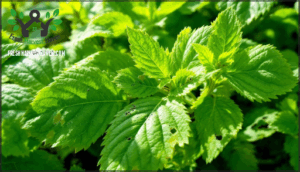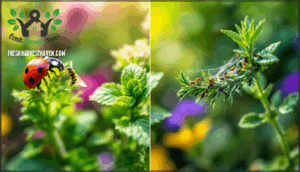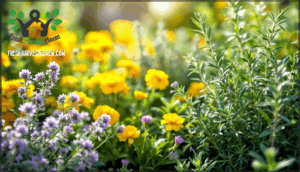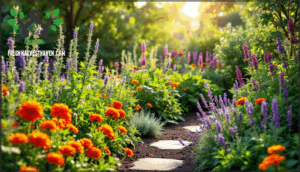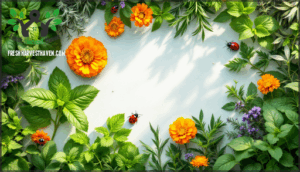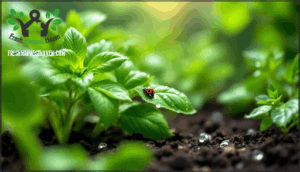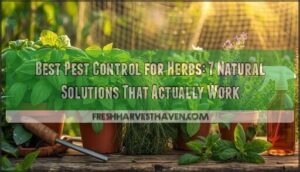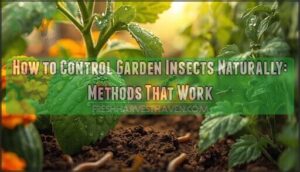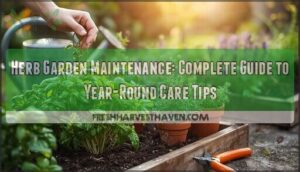This site is supported by our readers. We may earn a commission, at no cost to you, if you purchase through links.
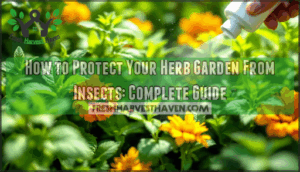
Healthy herbs naturally resist many invaders, but when pests do show up, combining the right repellent plants with simple organic methods creates a defense system that keeps your garden thriving. You’ll discover that a few strategic choices make all the difference between a pest-riddled patch and a flourishing harvest.
Table Of Contents
Key Takeaways
- Combining repellent herbs like basil, chives, and garlic with companion planting strategies can reduce pest populations by 30-75% without chemicals, making strategic plant placement your most powerful defense.
- Early detection through twice-weekly inspections of leaf undersides catches infestations before they cause serious damage, since healthy herbs naturally resist pests better than stressed plants.
- Organic controls like neem oil, horticultural soaps, and physical barriers (row covers blocking 95% of pests) work effectively when applied consistently every 7-14 days during early morning or evening.
- Attracting beneficial insects through diverse plantings with umbelliferous herbs and nectar-rich flowers slashes pest outbreaks by 35-40% while building a self-regulating garden ecosystem.
Identifying Common Herb Garden Pests
Your herb garden’s biggest threat isn’t always obvious—pests often hide in plain sight, feeding on your plants before you notice the damage. The good news is that once you know what to look for, spotting trouble becomes much easier.
Let’s walk through the most common culprits that attack herb gardens, how to spot their handiwork, and how to tell the good bugs from the bad ones.
Aphids, Whiteflies, and Spider Mites
Three pests commonly infiltrate herb gardens: aphids, whiteflies, and spider mites. Aphids are tiny soft-bodied insects that reproduce rapidly, sometimes birthing up to 100 nymphs per generation. Whiteflies cluster on leaf undersides, feeding on plant sap and potentially spreading diseases. Spider mites thrive in hot, dry conditions, spinning fine webbing as they drain your plants.
All three pests use piercing-sucking mouthparts, causing yellowing, leaf curling, and stunted growth. You’ll notice honeydew residue (sticky coating) and sooty mold development.
Attracting beneficial insects like ladybugs can help control aphid populations. Regular inspection catches infestations early, preventing 20–80% yield loss in susceptible herbs.
Leafhoppers and Leaf Miners
While aphids and spider mites are common troublemakers, leafhoppers and leaf miners operate differently—and knowing the difference helps you protect your herbs.
Leafhoppers are tiny wedge-shaped insects (about 3 mm) that feed on leaf undersides, creating a characteristic V-shaped yellowing called hopper-burn. Leaf miners, on the other hand, are small fly or moth larvae that tunnel inside leaves, leaving white or yellow serpentine tracks. Both pests weaken plants, but leaf miners can reduce yields by 30–60% in severe cases.
The good news? Healthy, well-irrigated herbs tolerate moderate leafhopper feeding. To manage these pests, consider cultural controls like removing crop residue. For organic control, neem oil and spinosad sprays work well. IPM strategies—rotating pesticide classes and removing crop residue—prevent resistance buildup. Resistant alfalfa varieties like Kanza show promise, and physical barriers like fine mesh reduced leaf miner attacks by 40% on farms in 2024.
Recognizing Signs of Pest Damage
Now that you know what leafhoppers and leaf miners do, it’s time to spot the damage they leave behind. Your herbs will show you exactly what’s wrong if you know what to look for.
Start by checking your plant leaves closely. Here’s what pest damage usually looks like:
- Leaf discoloration and stippling: Sap-sucking insects like aphids and spider mites create yellow or brown spots on leaves, often with sticky honeydew residue that attracts ants and promotes sooty mold growth.
- Visible webbing and tunneling: Spider mites spin fine webbing across stems and leaf undersides, while leaf miners leave serpentine white or yellow tracks inside leaves.
- Chewing damage and frass evidence: Caterpillars and beetles create irregular holes or skeletonized leaves, leaving behind small black pellets (frass) on soil or foliage.
Identifying pests on herbs early stops infestations fast. Check leaf undersides regularly—that’s where most troublemakers hide. Weak or stressed plants attract more pests, so healthy herbs are your best defense.
Differentiating Between Pests and Beneficial Insects
Your eyes are your best defense—and they’re free. Good news: beneficial insects look and act nothing like pests. Lady beetles and parasitic wasps wear bright warning colors, while aphids and spider mites hide in cryptic browns and greens.
Watch how they move: beneficial insects dart irregularly between flowers hunting nectar, whereas pests cluster on leaf undersides repeating the same feeding spots. Check undersides with 10× magnification monthly—you’ll spot the difference fast.
Gardens with higher beneficial insect diversity experience 35% fewer pest outbreaks annually, so learning to spot allies versus enemies gives you real control over your herb garden’s health.
Choosing Herbs That Repel Insects
Here’s the thing: certain herbs aren’t just delicious to cook with—they’re also natural pest fighters. Nature has equipped plants like chives, marigolds, and rosemary with compounds that repel the insects that commonly plague herb gardens.
By strategically planting these protective herbs alongside your other plants, you’ll create a built-in defense system that keeps pests away without any chemicals.
Best Pest-Repellent Herbs for Your Garden
When you’re growing herbs, think of pest-repellent plants as your garden’s bodyguards. Basil stands out—its essential oils block mosquitoes for up to two hours and slash whitefly populations by 58%. Chives pack a punch too, cutting carrot flies by 62% and aphids by 42%. Garlic works overtime, dropping aphid numbers 79% within days. Lavender repels mosquitoes at 93% effectiveness, while mint crushes aphids by 47%.
Treat pest-repellent herbs like basil, chives, garlic, lavender, and mint as your garden’s bodyguards—they slash pest populations by 42% to 93% naturally
These natural pest repellents aren’t just culinary stars; they’re your scent-based deterrents against common garden invaders, weaving protection and flavor into one smart garden strategy.
How Each Herb Deters Specific Pests
Each herb packs its own chemical arsenal against garden invaders. Catnip’s nepetalactone repels over 10 pest types—it’s 10 times more effective than DEET against mosquitoes. Garlic’s sulfur compounds slash aphid populations by 79% within days. Rosemary’s terpenes ward off whiteflies and carrot flies, while mint oils inhibit mosquito receptors by nearly 50%. Thyme vapors achieve 100% repellency against bean weevils.
These natural insect repellents weave protection through olfactory confusion, disrupting pest targeting behavior and making your herbs formidable defenders.
Planting Strategies for Maximum Protection
To heighten your herb garden’s defensive power, position pest-repelling plants strategically—think of them as bodyguards for your vegetables. Place stronger-scented herbs like basil, rosemary, and sage within 12 inches of susceptible crops; this proximity reduces aphid and mite colonization by 30%. Rotating herb clusters annually cuts overwintering pests by 50–60%, while raised beds with alternating herb bands spaced 12–18 inches apart lower whitefly activity by 39%.
- Intercropping benefits: Mix three or more aromatic species to achieve 42% better pest deterrence through overlapping scent profiles
- Perimeter borders: Frame your beds with chives or mint for full-coverage pest exclusion on 70% of border areas
- Structural diversity: Combine herbs of varying heights to attract 30–35% more beneficial insects like parasitic wasps and ladybugs
This multi-layered approach weaves natural repellence throughout your space, letting your herbs work together rather than alone.
Companion Planting for Natural Pest Control
You don’t need fancy chemicals or complicated techniques to protect your herb garden—nature does most of the work for you. By planting the right herbs alongside your vegetables and other garden plants, you can create a natural defense system that keeps pests away while bringing in beneficial insects.
Here’s how to design your garden for maximum protection.
Pairing Herbs With Vegetables for Protection
Want tomatoes that thrive? Plant basil nearby—it’ll cut hornworm damage by 60%. That’s companion planting at work. Pairing herbs with vegetables creates natural pest barriers through shared chemical signals.
Rosemary intercropped with beans boosts yield by 20% while deterring beetles. Sage reduces cabbage moth leaf damage by 30–45%. Space small herbs like basil 8–12 inches from vegetables to boost airflow and pest deterrence.
Alternating herb-vegetable rows lowers pest concentration by 42% compared to clustered arrangements. These vegetable-herb ratios deliver real ecological effects: better yields, healthier soil, fewer pests—all without synthetic sprays.
Attracting Beneficial Insects With Companion Plants
Here’s the thing: beneficial insects are your garden’s secret workforce. They’ll slash pest populations by 40% compared to gardens without them—but only if you give them what they need. That’s where insectary plantings come in.
Umbelliferous herbs like dill and cilantro attract parasitic wasps and lacewings that devour hundreds of aphids weekly. Marigolds? They pull hoverflies and ladybugs while cutting soil pests by 90%. Sweet alyssum, zinnias, and nasturtiums work similarly, creating diverse species that bloom across seasons.
The payoff: when you weave companion planting with these nectar-rich plants, you’re designing habitat complexity that naturally regulates pests year-round without sprays.
Layout Tips for Herb Garden Biodiversity
Think of your herb garden as a living patchwork quilt—each piece needs thoughtful placement to create the full picture. Structural variation matters: quadrant layouts with triangular groupings of three herbs boost beneficial insect richness by 34% compared to straight rows. Mix heights, textures, and bloom times to build habitat features that attract pollinators and natural pest controllers year-round.
Here’s your biodiversity blueprint:
- Space herbs 12 inches apart using grid guides to prevent crowding and increase yields by 18%
- Alternate tall and short plants along borders to create vertical layers that support diverse insect habitat
- Include woody perennials with annuals to raise crop diversity and beneficial species by 20%
- Repeat key companion planting species diagonally across beds to reduce pest migration gaps by 13%
- Add water features or pond edges near herb patches to boost predatory insect populations by 14%
This approach to species richness doesn’t just look good—it actively suppresses pests while attracting beneficial insects that keep your garden thriving.
Organic Pest Control Methods for Herbs
When pests show up despite your best companion planting efforts, you’ll need a few organic control methods in your toolkit. The good news is that protecting your herbs doesn’t require harsh chemicals—simple, natural solutions work surprisingly well.
Let’s look at three effective approaches you can start using right away.
Using Neem Oil and Horticultural Soaps
When pests invade, neem oil and horticultural soaps become your organic pest control frontline. Neem oil delivers dual action—contact kill plus systemic deterrence—while insecticidal soap targets soft-bodied insects on contact. Here’s how they compare:
| Feature | Neem Oil | Horticultural Soaps |
|---|---|---|
| Best For | Aphids, whiteflies, thrips, fungal issues | Aphids, mealybugs, spider mites |
| Residual Effect | 1–3 days | None after drying |
| Application Timing | Early morning or evening | Early morning or evening |
Mix neem oil at 0.5–2% concentration and reapply every 7–14 days. Combined treatments boost spider mite mortality by 25%. Both break down quickly—neem oil efficacy fades within days, and soap application timing matters since it only works wet.
You’re protecting herbs from pests without harming pollinators or soil health, and resistance development stays minimal with rotation.
Homemade Organic Bug Sprays
You can whip up powerful natural pest control solutions right in your kitchen. A garlic–mint–cayenne spray knocks out basil pests in three days, while tomato leaf infusions kill aphids and mites on contact.
Mix garlic spray at 2% concentration for 70% fewer soft-bodied insects.
Apply these homemade bug sprays every 3–7 days under cloudy skies—organic bug sprays work best through direct contact and cost pennies compared to commercial options.
Physical Barriers and Manual Removal Techniques
Beyond sprays, physical barriers like floating row covers block up to 95% of flying pests when installed right after planting. Fine mesh allows sunlight through while keeping aphids out.
Manual removal works too—handpicking beetles daily eliminates 75% of visible pests, while a strong water spray dislodges mites instantly. Combine both methods for 70–90% fewer pests.
Check barriers every few days for tears, and watch for overheating under covers during hot spells.
Maintaining a Healthy, Pest-Resistant Herb Garden
The best defense against pests isn’t just spraying something when bugs show up—it’s building a garden that’s naturally strong enough to resist them.
When your herbs get the right water, soil, and care, they’ll grow vigorously and shrug off most pest problems on their own.
Here’s how to keep your herb garden healthy and pest-resistant from the ground up.
Proper Irrigation and Soil Management
Your herbs need a solid foundation to thrive and fend off pests. Soil drainage is critical—mix in organic compost and add drainage solutions like perlite to keep oxygen flowing. Lay down 1–2 inches of mulch for soil moisture stability and pest suppression.
Water deeply to about 6–12 inches, reaching root systems without drowning them. Drip irrigation delivers water right where it counts, boosting soil health without inviting fungal trouble.
Pruning and Removing Infested Foliage
Regarding keeping your herb garden healthy, pruning is your first line of defense against pest infestation. Snip off damaged leaves showing yellowing, curling, or stippling—signs that aphids or mites have moved in.
Disinfection techniques matter: wipe your shears with rubbing alcohol between cuts to stop spreading trouble. Cut about two inches below visible damage for complete pest removal, then seal those clippings in a bag instead of tossing them on the compost pile.
This IPM integration approach can slash your need for sprays by up to 70%.
Regular Garden Maintenance Practices
Weekly inspections are crucial for a thriving herb garden. Scan leaf undersides and stem bases where pests often hide. Install yellow sticky traps to catch aphids early, and monitor soil health by maintaining a pH between 6.0 and 7.0.
Proper maintenance includes cleaning tools with rubbing alcohol after each use and applying mulch 10–15 cm from stems. Remove plant debris seasonally to prevent pest habitats.
Drip irrigation is superior to overhead watering as it reduces pest-friendly humidity zones. Additionally, maintaining a well-kept garden attracts beneficial insects, further enhancing your herb garden’s health.
Frequently Asked Questions (FAQs)
What pests attack herb seedlings or young plants?
Your young herbs face a perfect storm of threats. Aphids, spider mites, whiteflies, thrips, cutworms, and fungus gnat larvae attack vulnerable seedlings, causing root damage, wilting, and stunted growth—but prevention tactics work.
How do I treat fungal infections organically?
Fungal diseases like powdery mildew and rust respond well to organic fungicides such as neem oil, sulfur, and baking soda solutions.
Cultural practices—avoiding overhead watering, improving airflow, and removing infected leaves—prevent most infections.
Biological controls and integrated strategies boost success rates above 70%.
When should I inspect herbs for pest problems?
Check your herbs at least twice weekly for early pest detection. Inspect during early morning or late evening when pests are most active.
Pay special attention during vulnerable stages like seedling and flowering, and after environmental triggers such as high humidity or heat waves.
Can indoor herbs get the same pests?
Like plants that share water and sunlight, indoor herbs also share their enemies.
Yes, your indoor herbs can get the same pests as outdoor ones—aphids, spider mites, and whiteflies are frequent visitors when you bring plants inside or use contaminated soil.
What natural predators eat herb garden pests?
Ladybugs, lacewings, parasitic wasps, and predatory mites are your garden’s pest control squad. These beneficial insects can slash aphid, whitefly, and spider mite populations by 60-80%.
Attracting predators with native plants like dill, fennel, and goldenrod boosts biological control naturally.
Conclusion
Studies show that gardens with companion planting reduce pest populations by up to 75% compared to monoculture beds. That’s the power of protecting your herb garden from insects through layered strategies—repellent plants, beneficial insects, and organic treatments working together.
You’ve learned to spot troublemakers early, choose the right herbs, and maintain healthy soil that naturally resists invaders. Your garden won’t need chemical rescue missions when you’ve built a resilient ecosystem from the ground up.
Now it’s time to put these techniques into action and watch your herbs flourish.
- https://ipm.cahnr.uconn.edu/herbs-greenhouse/
- https://growcycle.com/learn/pest-control/residential-and-commercial-pest-control/herb-garden-rescue-how-to-identify-and-treat-common-pests-and-diseases
- https://extension.umd.edu/resource/herb-problems
- https://www.aphis.usda.gov/plant-pests-diseases/biocontrol
- https://pmc.ncbi.nlm.nih.gov/articles/PMC2610108/

